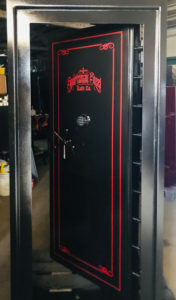Vault doors are an integral component of secure storage systems, providing protection for valuable assets, sensitive information, and even people in certain cases. These doors are designed to be impenetrable, resisting various threats, including unauthorized access, theft, fire, and even natural disasters. Here’s an insight into the technology and engineering behind these formidable structures:

1. Materials:
- Heavy-duty Steel: Vault doors are typically constructed from high-strength steel, which offers exceptional durability and resistance to physical attacks.
- Armor Plating: Some vault doors feature additional armor plating to enhance their resistance to explosives and heavy-duty tools.
- Fireproofing: Fire-resistant materials may be integrated to protect contents from high temperatures and flames.
2. Locking Mechanisms:
- Combination Locks: Traditional vault doors often employ combination locks with intricate and confidential combinations.
- Electronic Locks: Modern vault doors frequently use electronic locks that can be controlled and monitored remotely, allowing for quick access when needed.
- Biometric Scanners: For an extra layer of security, biometric scanners like fingerprint or retina recognition may be integrated into vault doors.
- Time Locks: Some vaults have time locks, which restrict access during certain hours, preventing unauthorized entry even if the correct combination or credentials are known.
3. Reinforcements:
- Reinforced Hinges: Vault doors are equipped with heavy-duty hinges that can withstand tampering and attacks.
- Boltwork Systems: These are massive locking bolts that engage when the door is closed, securing it in place. The number and size of bolts can vary, with some doors having multiple tiers of boltwork.
- Relocking Devices: If tampered with, some vault doors have relocking devices that trigger additional locks to engage automatically.
4. Resistance to Force and Drilling:
- Hardened Steel Plates: The door’s exterior is often reinforced with hardened steel plates to resist drilling and cutting attempts.
- Concrete Filling: Some vault doors have a concrete filling in the door’s core, making it difficult to penetrate even with power tools.
- Anti-Penetration Measures: Special designs may be incorporated to prevent the insertion of tools or explosives into gaps around the door.
5. Security System Integration:
- Surveillance Cameras: Vault doors are often monitored by surveillance cameras, providing real-time video feeds to security personnel.
- Alarms: Intrusion detection systems are commonly integrated, alerting authorities in the event of unauthorized access attempts.
- Access Logs: Electronic vaults maintain detailed access logs, ensuring accountability and traceability.
6. Environmental Protection:
- Sealing Mechanisms: Vault doors are designed to create airtight seals to protect contents from environmental factors, including dust, moisture, and gases.
- Fireproofing: Fire-resistant materials and seals can protect contents from fire and smoke damage.
7. Customization:
- Vault doors can be customized to meet specific security needs, including size, locking mechanisms, and access control methods.
Vault doors represent the pinnacle of security technology and engineering, providing peace of mind to organizations and individuals seeking to protect their most valuable assets. Their design combines robust materials, sophisticated locking mechanisms, and integrated security systems to create nearly impenetrable barriers against threats of all kinds.
